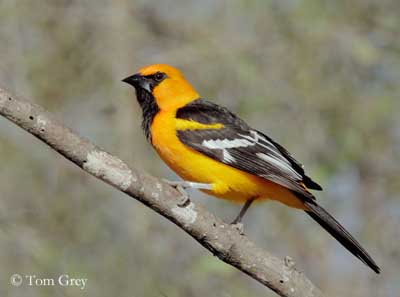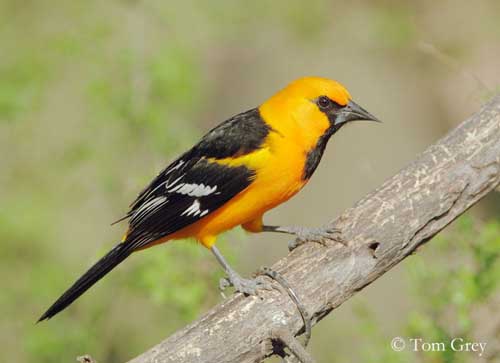
The female lays 3 to 4 pale blue eggs with darker spots and blotches. Incubation lasts about two weeks, by female. Both parents feed the chicks, but the fledging age is unknown at this time.
Parents and young remain in the surrounding of the nest, during one week after fledging.
If the adults start a second brood, the young from the first clutch remain near the nest, sometimes begging for food and being fed, but sometimes chased off. The young reach their sexual maturity at one year.
This species may produce one or two broods per season.
DIET:
The Altamira Oriole feeds mainly on insects, but it also consumes fruit and nectar. It can eat seeds and nuts thanks to the size and the structure of its bill.
PROTECTION / THREATS / STATUS:
The Altamira Oriole helps in the dispersal of fruit seeds, and they are important insect predators.
The populations seem to be stable, even if some local populations may be affected by habitat loss.
Fr: Oriole à gros bec
All : Schwarzkehltrupial
Esp : Turpial Campero
Ital : Oriolo di Altamira
Nd : Altamiratroepiaal
Sd : Altamiratrupial
Photographers:
Jean Michel Fenerole
Photos d’Oiseaux du monde
Tom grey
Tom Grey's Bird Pictures
Texte de Nicole Bouglouan
Sources:
NEW WORLD BLACKBIRDS – THE ICTERIDS by Alvaro Jaramillo and Peter Burke – Helm - ISBN : 0713643331
FIELD GUIDE TO THE BIRDS OF NORTH AMERICA - National Geographic Society - ISBN: 0792274512
A GUIDE TO THE BIRDS OF MEXICO AND NORTHERN CENTRAL AMERICA by Steve N. G. Howell, Sophie Webb - Oxford University Press - ISBN: 0198540124
All About Birds (Cornell Lab of Ornithology)
The Birds of North America online
What Bird-The ultimate Bird Guide (Mitchell Waite)
BirdLife International (BirdLife International)
XENO-CANTO – Sharing Birds sounds from around the world
Altamira Oriole
Icterus gularis
Passeriforme Order – Icteridae Family
BIOMETRICS:
Length: 21-25 cm
Wingspan: 34-38 cm
Weight: 53-64 g
DESCRIPTION:
The Altamira Oriole is a brightly coloured songbird and the largest oriole of the United States.
Both sexes have bright orange plumage, except for upper back, scapulars, lores, throat and tail which are black.
The wings are mostly black, but we can see an orange triangle formed by the lesser coverts, a broad white wing bar on greater coverts, and white edges on tertials, secondaries and bases of outer primaries.
The black bill is thick and straight, with blue-grey base. The eyes are dark brown. Legs and feet are bleu-grey.

The female is similar, but she may have slightly smaller black throat patch, and she is smaller than the male.
The juvenile has olive-brown back, wings and tail. Head and underparts are dull yellow. Lores are dark but it lacks black throat. We can see some white spots at primary bases.
The first year resembles adult, but more yellowish-orange, olive upper back and faint white wing bars. Black bib is yet present.
Similar species:
The Hooded Oriole is smaller, with thinner bill and conspicuous white wing bars.
The Streak-backed Oriole is more reddish-orange, and the orange back is streaked with dark colour.
There are six subspecies which differ slightly in plumage colour with more or less orange or yellow, and in size.
VOICE: SOUNDS BY XENO-CANTO
The Altamira Oriole’s contact call is a nasal, raspy “ike-ike-ike”. The alarm call by female is a harsh “keeeer” when the predator approaches.
The song is a series of clear, varied, but hesitant whistles, sometimes interspersed with harsh notes as rasping chatter which may signal alarm.
HABITAT:
The Altamira Oriole frequents semi-arid areas with scattered trees, and open areas within wet environment such as swamp forests, but also in arid woodlands such as tropical deciduous forests or tropical scrub, and riparian areas.
It is found from sea level up to 1500 metres of elevation. It also may nest in suburban or rural gardens if there are patches of thorn forest nearby.
RANGE:
The Altamira Oriole is common in the subtropical lowlands of the Mexican Gulf Coasts and northern Central America, and also in the extreme south of Texas.
The Altamira Oriole is permanent resident in its range.

BEHAVIOUR:
The Altamira Oriole gleans in foliage, from tree top to near ground. It is mainly insectivorous, but it may sometimes consume fruit and nectar.
They are often seen in pairs, but they are solitary nesters and the distance between two nests may be up to 250 metres. The birds do not defend actively the territory, probably due to dispersed nesting-sites. The rare disputes involve some displays by both sexes, such as the ritual “bill-up” posture when a bird is perched in tree.
The Altamira Orioles are monogamous, and they probably remain together year-round and for life. Both mates maintain contact calls during the nesting period. the male follows the female while she collects nest materials, and it remains nearby during nest building, incubation, and when she broods the chicks.
The Altamira Orioles form feeding flocks during winter, and they may feed with other bird species.
They chase the Bronzed Cowbird which parasitizes their nests. The nests may be abandoned by the orioles, but sometimes, they remove the Cowbird’s eggs from the nest. They also may build a new nest in the same tree or nearby, if the first is parasitized.
The Bronzed Cowbird may peck small holes in Orioles’ eggs, after laying their own eggs. Some Altamira Orioles may rear Bronzed Cowbird’s young.
The Altamira Oriole defends the nest against predators such as birds of prey, jays and other bird species, chasing them away from the nest-site.
FLIGHT:
The Altamira Oriole has quick and jerky flight when moving from branch to branch. It may perform swift flight with rapid wing beats.
REPRODUCTION:
Altamira Oriole’s nest is located at tip of branch, and it is rarely hidden. It also may be located in dead branches of live or dead tree, telephone wires and other supports. It is situated at about 9 metres above the ground.
The female probably builds the nest in three weeks or more. This one is similar to a long bag, suspended from a twig near the tip of the branch. It is made with woven with rootlets and long fibres of vines, strips of palm fronds, long leaves, grasses, the inner bark of trees and horse hair. The interior is lined with plant down, fine straw, horse hair, wool or feathers. This lining only covers the bottom of the “bag”. The entrance is situated at the top of this pear-shaped nest. It may size up to 65cm in length. The Altamira oriole starts to build the nest in March. This kind of structure is inaccessible for terrestrial predators.
